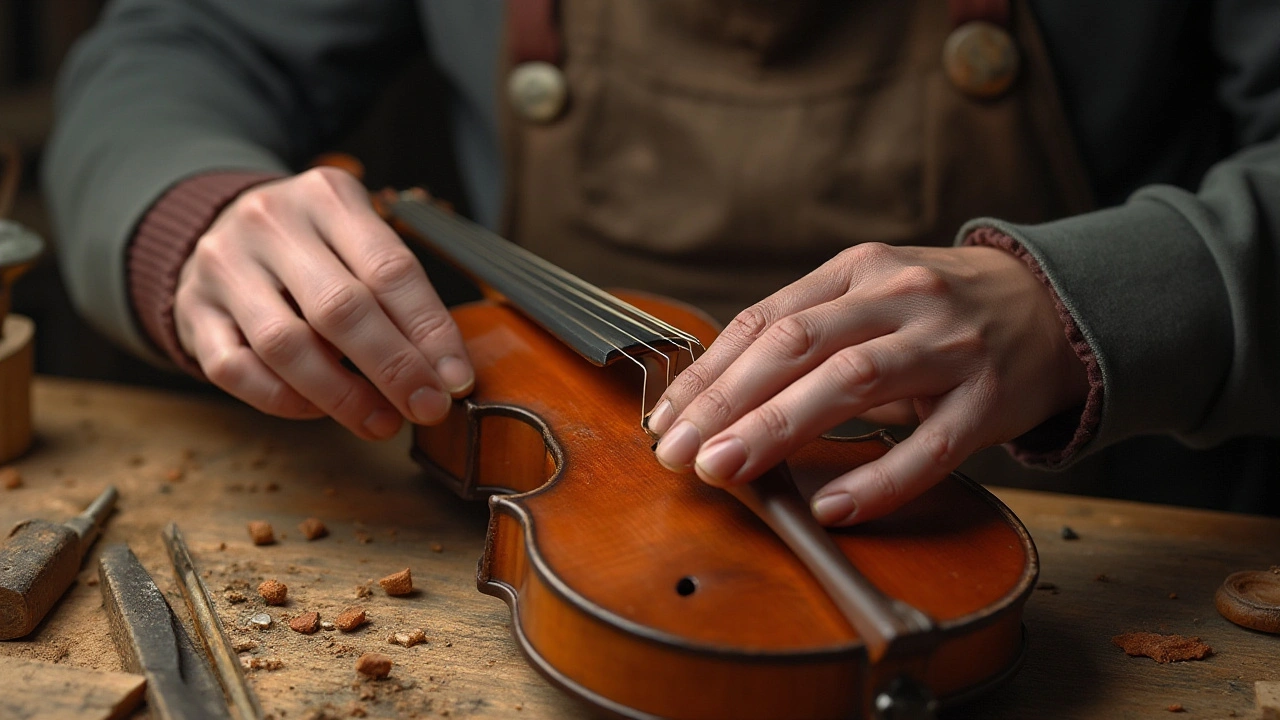Music, the universal language, speaks to us through an orchestra of instruments that each tell a story of vibration and resonance. But how exactly do these wondrous tools of sound work? The answer lies within the physics that governs every note we hear. From the gentle hum of a violin's strings to the bold blast of a trumpet, musical instruments harness natural laws to create melody and rhythm.
In this exploration, we will dive into the world of sound, examining the mechanics of various musical instruments. By understanding the principles that bring music to life, we gain appreciation not only for the artistry but also for the fascinating science that supports it. Whether you're a musician, a science enthusiast, or just curious about what happens behind the musical curtain, this journey through sound promises to enlighten and inspire.
- Introduction to Sound and Music
- String Instruments: Vibrations and Resonance
- Wind Instruments: The Power of Air Flow
- Percussion Instruments: Rhythm Through Impact
Introduction to Sound and Music
From the gentle rustling of leaves to the soothing rhythm of ocean waves, sound envelops our lives with an often unnoticed presence. When it comes to musical instruments, these seemingly magical objects have the incredible ability to transform the everyday phenomenon of sound into a structured, harmonious art form that resonates deeply within us. The fundamental building blocks of this transformation are the vibrations that instruments produce. These vibrations travel through the air as waves, eventually reaching our ears where they convert into electrical signals that our brains decipher as music.
At the heart of musical instruments lies the science of acoustics. This branch of physics delves into how sound behaves and travels through different environments. Acousticians study the characteristics of sound waves, including their frequency, wavelength, and amplitude. Each element plays a critical role in defining the pitch, loudness, and quality of the sound produced by an instrument. To master the art of creating music, one must first grasp these basic ingredients, as every note and tone relies on them.
"Music is the shorthand of emotion," observed Leo Tolstoy, capturing how these waves of sound embody the range of human feelings like no other medium can.
A remarkable fact about sound waves is how they interact within and outside the instrument. Inside a violin or a guitar, for instance, the body of the instrument amplifies the sound through resonance. Such resonance is essentially the reinforcement of sound through the matching of a sound wave's frequency with the natural frequency of the instrument's body. This amplification gives each instrument its unique, rich voice. When listening to a violin quartet, the distinctive timbre of each violin is a direct result of this fascinating interaction between physics and craftsmanship.
The science doesn't stop with the violin. Consider woodwind instruments, which rely on controlled pulses of air to initiate sound waves. These instruments use the length of their air columns to change pitch—a longer column produces lower pitches, while shorter columns yield higher sounds. This simple adjustment of air, coupled with the intricacies of key structures, offers musicians a broad spectrum of musical expression. Meanwhile, percussion instruments harness a different principle known as impact-based resonance. Striking a drumhead or a marimba bar sets off vibrations that produce sound, the quality of which is determined by the material and tension of the surface being struck.
The intriguing world of music marries art with science, giving us a glimpse into how humans have harnessed natural phenomena to craft expressions of joy, sorrow, and everything in between. By exploring the basic yet profound concepts underpinning sound and music, we embark on a journey of discovery, gaining insight into how these vibrations echo throughout history and resonate within us today.

String Instruments: Vibrations and Resonance
String instruments have a magical way of channeling the energy of vibrations into sound that can stir our emotions. Vibrations are at the heart of how these instruments work, starting their journey each time a bow is drawn across a violin string or a guitar is strummed. The fascinating thing is that when these strings vibrate, they don't just produce one note but a complex amalgamation of harmonics, which gives each instrument its distinctive tone. When you pluck a string, it moves in more than one way, simultaneously initiating a fundamental frequency and a series of overtones, which all resonate together. These overtones are what differentiate a piano from a harp even if they are playing the same pitch.
The role of resonance in string instruments cannot be overstated. The body of the instrument acts as a resonator, enhancing the sound produced by the strings. Think of it as an amplifier without the electronics. Made from various woods, often chosen for their specific acoustic properties, the body boosts the vibration frequency. A well-made violin resonates effortlessly, its smooth timbre filling a room with a sort of warmth that everyone can feel. As Albert Einstein once said, "The violin’s strings are a galaxy of vibrations." This intricate layering of sound allows even a single note to evolve in character and intensity.
“Without music, life would be a mistake.” – Friedrich Nietzsche
Now, let’s take a closer look at some interesting data about common string instruments. Each string instrument operates on the same law of vibration, yet their constructions result in beautifully varied expressions. For instance, a cello's larger structure compared to a violin enables it to produce deeper, richer tones. Depending on the string's length, tension, and mass, the pitch can be altered drastically. Here’s a table that shows the relationship between string length and pitch across popular string instruments:
| Instrument | String Length (inches) | Typical Pitch Range |
|---|---|---|
| Violin | 11.5 – 12.5 | G3 to A7 |
| Viola | 14.5 – 15.5 | C3 to E6 |
| Cello | 27 – 28 | C2 to G5 |
| Double Bass | 41.5 – 43 | E1 to G4 |
In addition to enhancing the vibrations, the instrument's body influences the decay of sound, how it fades away. This relies heavily on how the materials absorb and release energy. The finesse lies in crafting the body to control these variables, ensuring the sound projected remains pleasant and full. Builders, also known as luthiers, spend years refining their skills to strike the perfect balance, often relying on techniques passed through generations. Instruments like the Stradivarius violins are renowned for their harmonious blend of vibration and resonance, leading many to attempt replicating their secret—all in quest of that ideal, untouchable sound. So next time you hear a string instrument playing, picture the elegant dance of physics at play, creating music that speaks to the soul.

Wind Instruments: The Power of Air Flow
Wind instruments are fascinating creations that turn the simple act of blowing air into breathtaking music. The magic happens when a player blows into or across the mouthpiece, setting up vibrations that travel through the instrument's body. These vibrations are manipulated by keys or holes, creating the notes we hear. This family of instruments includes the likes of flutes, clarinets, oboes, and trumpets, each employing air flow in unique ways. From tiny piccolos chirping high above the orchestra to majestic tubas laying down rich bass lines, they are united by the physics of sound waves traversing a column of air. It's remarkable to think that all this starts with nothing more than a breath. The length and shape of the instrument determine the speed and pattern of the sound waves within, which ultimately affects the pitch and tone. This is why each wind instrument has its own distinct voice.
The relationship between the musician's breath and the instrument's register is intricate. Precision in breath control can enhance sound, affect pitch, and create dynamics. For instance, a flute player must vary their air speed and direction to produce different notes and even change octave ranges. The more skilled musicians become in managing their breath, the more expressive they can be. It's no wonder that wind instrument players often have to develop lung capacity and endurance, sometimes likened to athletes in their own right. There’s an interesting phenomenon that when air flows through these instruments at just the right velocity, it creates harmonics, enriching the sound by adding depth and complexity. This interplay of air and acoustics is central to how wind instruments captivate audiences with their melodic allure.
The Physics of Timbre and Dynamics
Each wind instrument's timbre, or voice, owes its character to its design and material. Different metals, woods, and shapes influence the air column resonating inside. For a brass instrument like a trumpet, the player's buzzing lips serve as a vibrating valve that channels the air, whereas a tiny reed vibrates in a clarinet or an oboe. Fascinatingly, the material and bore size—be it cylindrical or conical—impact the sound quality, contributing to each instrument's unique sonic footprint. It's not just about aesthetics; the resonance and timbre are profound results of these components working in mystical harmony. Also, wind instruments can change dynamics by adjusting breath pressure, volume, and speed, allowing musicians to convey emotion with powerful crescendos or subtle decrescendos.
"The horn was the invention of man once he was prepared to raise his hand to the gods. Its music filled space with the echoes of heaven." — Hermann Hesse
Exploring these elements can be both enlightening and essential for anyone wanting to master a wind instrument. The ability to control these dynamics helps develop a more personal voice on the instrument, enabling one to play expressively and connect more deeply with the audience. This personal touch, grounded in technical skill and understanding of the science behind the instrument, turns mere notes into artistry.

Percussion Instruments: Rhythm Through Impact
Percussion instruments hold the vital role of the heartbeat in music. They create rhythm and excitement, setting the tempo that guides every other instrument in an ensemble. At the core of their magic is a simple principle: impact. When you strike a drum, for instance, it vibrates. These vibrations create sound waves that travel to our ears, interpreted as beats of varying intensity. The uniqueness of each percussion instrument's sound comes from its shape, size, and the materials from which it's crafted.
Consider the variety within percussion instruments, like the delicate maracas or the profound timpani. Each instrument within this family emphasizes different resonating qualities. Drums, with their tense membranes, produce vibrant and resonant tones, while cymbals cut through with sharp, metallic clashes. These differences arise not only from physical structure but also from a player's touch and technique, which can pique the nuances of sound in ways science is still trying to completely understand.
Materials and Construction
The choice of materials in percussion instruments is crucial. Instruments like the djembe are carved from wood, creating a distinct, earthy sound, whereas steel drum pans, formed from metal, yield bright, melodic tones. These materials influence the way sound waves propagate within the structure and how they are projected outward. But it’s not just about the primary material; skins or membranes made from animal hide or synthetic fibers also add unique tonal qualities. The tension of these skins, often adjustable, allows control over pitch and resonance.
The acoustics of percussion are fascinating. As Victor Wooten once said, "Music doesn't lie. If there is something to be changed in this world, then it can only happen through music," underscoring how percussion indicates emotion through its very nature.
Rhythmic Patterns and Timing
Rhythm created by percussion instruments can be simple or complex, often based on traditional patterns known as rhythms or beats. These rhythms, whether it's the syncopated beats of jazz or the steady marches of classical symphonies, form the foundation upon which melodies are built. Timing and rhythm require precise coordination, a challenging task that percussionists master through practice and intuition. In domains like orchestral performances or contemporary bands, percussionists must anticipate the subtle shifts and changes in dynamic, complementing and leading the ensemble at critical moments.
Innovations and Technology
In the modern world, percussion instruments have evolved with technology. Electronic drums now replicate the sound of traditional percussion with amazing accuracy, offering choices of infinite customization. These innovations have made percussion more accessible, allowing musicians of all levels to experiment with rhythm and sounds previously difficult to achieve with acoustic instruments. Despite technological advances, the essence of percussion—impact and vibration—remains unchanged.
Percussion instruments have a profound ability to connect with human emotion. Their rhythmic impact resonates not only in sound but in the core of human experience, making them indispensable in music cultures worldwide. Whether through the reverberating echoes of a large gong or the gentle tick of a tambourine, the science behind these instruments exemplifies the deep and eternally fascinating relationship between physics and music.

